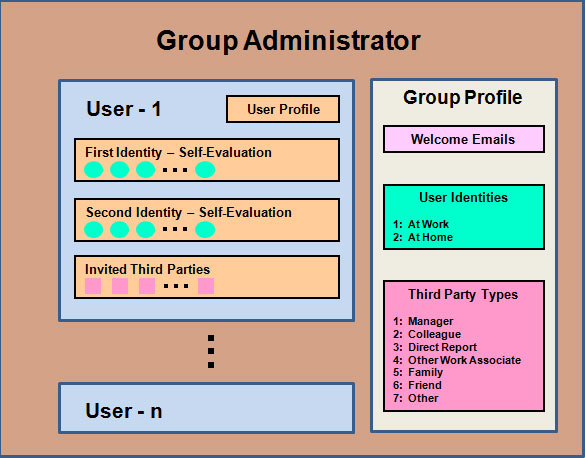
Drama Diagnostic Features | System Overview

Groups:
A Group consists of one or more users of the Drama Diagnostic. Every group has a unique name. For single-user groups the group name might be the user’s name. For multi-user groups the group name might be the organization name, a work group name, project team, or any other name that uniquely identifies the users.
Every group, including a single-user group, has a Group Administrator, who establishes the group profile, invites users to be part of the group and invites third parties to evaluate users. The Group Administrator also performs administrative functions for the group, such as customizing the welcome emails sent to users and third parties, changing the names of the user identities, and altering the names of the seven different third party types.
Users:
A User is any person who is invited by the Group Administrator to take the Drama Diagnostic. Each user has a unique ID (his or her email address) and password within the group.
A user’s behavior in the home environment may be different than his or her behavior in the work environment. The assessment’s Identity feature allows the user to choose which environment will be considered while taking the Drama Diagnostic. For example, the user might first take the Diagnostic considering his or her behavior at work. He or she might then take the Diagnostic a second time considering his or her behavior outside of work.
The Drama Diagnostic Report Generator lets the user choose which Identity will be used for creating the report.
Third Parties:
The Group Administrator may invite any number of third parties to evaluate a user. A third party receives an email from the Group Administrator explaining the Drama Diagnostic and inviting the third party to evaluate a specific user. After a third party evaluates a user a report is produced summarizing the third party’s assessment of the user.
The Drama Diagnostic allows seven different relationship types for third parties. The Group Administrator assigns a type to each invited third party. The Group Administrator may also change the names of these types.
The invitation email to the third party contains a unique Internet address for evaluating an individual user. To begin the assessment of the user, the third party simply clicks on the Internet address.
A third party may evaluate a user any number of times. Only the most recent assessment is stored in the system.